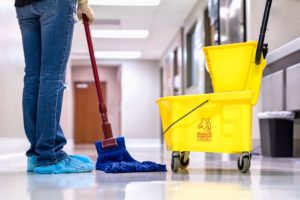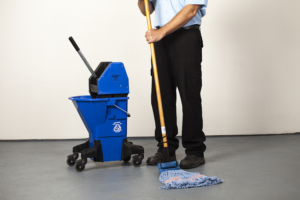Wet Mop Use and Care

Wet mops remain one of the most effective cleaning implements for commercial facilities. They work for any material, with the exception being wood, laminate, and other water-sensitive flooring materials. However, you need to follow a wet mopping procedure that gets your floor totally clean.
Mopping is generally preferred for kitchens, dining areas, and other high-traffic locations. It leaves a floor looking fresh and protects it from damage by dirt and other particles. The following usage and care suggestions will help achieve a thorough cleaning every time.
How to Use a Wet Mop
Gather Equipment and Materials
You’ll need a few cleaning supplies to get started with mopping. Start the process by gathering a mop and the following:
- Broom/dustpan or vacuum cleaner
- Wash bucket and rinse bucket
- Cleaning rag
- Sponges
- Detergent
- Towels or other drying implement (if desired)
Prepare the Area
Place wet floor signs where needed to warn building occupants of potential slick spots. Remove furniture, entry mats, and other objects from the floor. To make cleaning simpler, designate 10×10-foot areas to clean at a time.
Start Cleaning
To avoid a bigger mess, sweep or vacuum the floor and wipe up any particularly dirty/sticky spots with a sponge and soapy water or floor cleaner. Dust mopping clears any debris so the wet mop won’t spread it around or make your cleaning solution muddy.
Mix the Water and Soap/Detergent Solution
Each bucket should be filled with hot water. More effective than cold or warm water, it should be mixed with mopping detergent in amounts suggested by the product label. Using more detergent will only make rinsing harder and won’t get the floor clean any faster.
Mop in a Figure 8 Pattern
A figure 8 pattern makes it harder to miss areas. It also allows for continuous motion and provides the advantage of overlapping, which improves coverage. Starting at an innermost corner means cleaning personnel are always standing on a dry section of the floor as they work toward the exit. This also avoids spreading water and soap to other areas or streaking the floor.
Repeatedly Rewet and Wring Out the Mop
Whenever you dip the mop in the bucket, wring it out by hand or with a wringer. Make sure the mop isn’t sopping wet, but just damp; this part of the wet mopping procedure reduces dry time and avoids potential water damage. Scrub grimy spots, tough corners, and edges with a sponge or paper towel.
Rinse the mop in the rinse bucket after you’ve covered the chosen section of floor. Dunk it up and down several times, and then wring the mop head to get rid of the dirty water.
Rinse Again with Clean Water
When you’ve covered the entire floor surface and it looks clean with no detergent residue, do a final rinse with clean hot water. Empty the rinse bucket and add fresh hot water for your final mopping. Not sure if a final rinse is necessary? Check the rinse water; if it got very sudsy or dirty, this last step is a good idea.
Mop Cleaning and Care Tips

Cleaning a mop is very important. A wet mop is designed to trap dirt and moisture. While this helps clean floors, it can easily soil the mop, spread contaminants, and support the growth of mold and mildew. Your mop can become smelly and harbor bacteria that can be spread. To avoid these issues:
- Wash the mop every time you use it, allowing it to dry completely.
- Use a different mop for different sections of your building.
- Clean with a low-alkaline, low-caustic detergent.
- Avoid using bleach or fabric softener.
- Allow the mop to air dry in a well-ventilated area.
- For storage, hang the mop in a ventilated room, with the strands hanging down.
Order Quality Mops from Prudential Overall Supply
Prudential Overall Supply has grown from a uniform supply company to a leader in the Clean Green Sustainability Movement. Our products and customer service meet high-quality standards. We supply high-quality mops and dusting equipment to include in your wet mopping procedure and keep your facility consistently clean. Feel free to order online or call 800-767-5536 for help today.